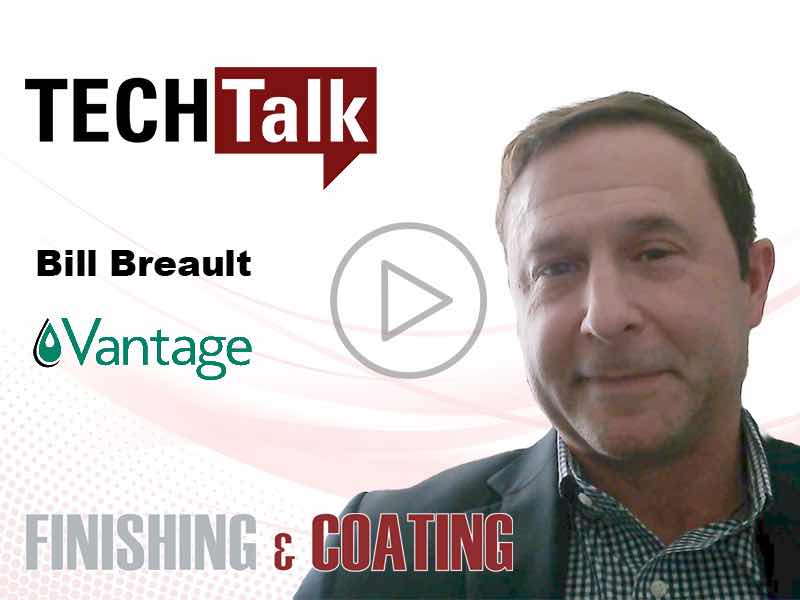Vantage Surface Treatment Technologies is part of a 40-year-old company that got its start in the late 1980s with the Montreal Protocol agreements.
That’s when the international treaty was signed to protect the ozone by phasing out the production of numerous substances that are responsible for ozone depletion.
Bill Breault, Sales Director at Vantage Surface Treatment Technologies, says the company created a range of cleaning products based on citrus and pine terpenes that are used for both cleaning and deflexing as an alternative to freon.
Engineered Solutions to Address Environmental Health, Safety Regulations
“The origin story of the business was in creating proprietary engineered solutions to address environmental health and safety regulations,” Breault says. “We developed, designed, and engineered surface treatments and pre-treatments to address issues like VOCs and ozone depletion, global warming depletion and potential.”
Vantage is based in Gurnee, Illinois, and continues to develop, manufacture, and supply a complete range of integrated process cleaning solutions, surface treatments, and pre-treatments for high reliability in markets such as aerospace, defense, electronics, medical device, and automotive.
Breault highlighted two products that Vantage offers surface finishers:
- BIOACT 105 Manual Solvent Cleaner is a blend of highly-refined solvents designed to replace hazardous solvents, including isopropyl alcohol, methyl ethyl ketone, and acetone. It is used for general-purpose degreasing as well as cleaning surfaces before bonding, sealing, and coating.
- BIOACT 280 is used in immersion tanks at full concentration. For effective removal, heat the BIOACT™ 280 bath to a temperature of 180°F to 200°For a temperature above the melting point of the masking wax. The wax will dissolve from the plated part; after wax removal is completed, components are rinsed in successive heated rinse steps.
Replacing Methyl Ethyl Ketone and Other Solvents
Breault says BIOACT 105 is designed for manual cleaning operations of both metallic and non-metallic substrates.
“It was originally engineered to replace methyl ethyl ketone — or MEK —and other solvents with high EH impact,” he says. “It is generally used for degreasing cleaning, but is also often used for preparing surfaces before bonding, sealing, and coating.”
BIOACT 105 is approved for SAE AMS 3167 QPL, Airbus AIMS 09-00-002, American Airlines, Bell Helicopter, Boeing D6-17487 (BSS 7432), Douglas CSD #1, Bombardier BAPS 180-009 General & Q400 AMM, CFM, GE Aviation, Gulfstream, Honeywell, IAE, Pratt & Whitney PMC 8929, Rolls-Royce CSS/OMat, United Airlines, AMS 1526, and AMS 3819 (BIOACT 105 Wipes).
Breault says that BIOACT 280 is a safer alternative to removing wax without using hazardous solvents. This bio-based product also exhibits very low odor, does not contain hazardous air pollutants, helps reduce VOC emissions, and has a bath life that averages 18 to 24 months.
Used in Landing Gear and Engine Overhaul
“This has been a very important product in our portfolio for many years,” Breault says. “It is predominantly used in aerospace, especially on the landing gear and engine overhaul side of the business where they are applying nickel sulfate in chrome plating. And in that particular process, there are areas of those components by which they do not want to plate.”
Shops will often use a microcrystalline wax for the areas to be masked, and in the past, often used products like trichloroethylene (TCE) or tetrachloroethene (PERC) to clean the parts, but the U.S. EPA had deemed those products carcinogens.
“BIOACT 280 was a response to the use of these hazardous carcinogenic materials,” Breault says. “The bioactivity is quite unique. It really is a bio-derived, bio-based solvent that has a high affinity for holding large amounts of wax. It has a very long bath life of somewhere between 18 and 24 months.”
The product is approved and conforms to Boeing D6-17487 (BSS 7432), CFM, GE Aviation, Honeywell, IAE, Pratt & Whitney PMC 8913, and Rolls-Royce CSS/Omat.




































